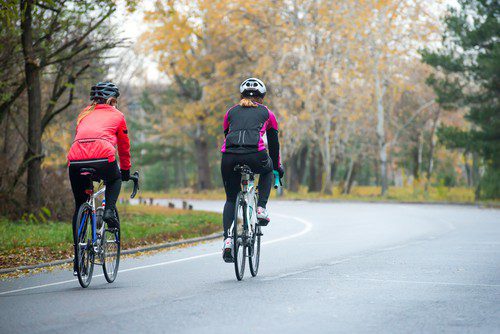Coming back to a beloved activity after a hiatus can be daunting, as you’ll want to get back to your previous level with as little investment as possible. Cycling especially can be challenging to come back to, with motivation and fitness-related concerns making it complicated. How do you get back into cycling after a long break?
Here’s how to get back into cycling after a long break:
- Understand that you’re not starting over.
- Set reasonable goals.
- Choose the right bike for maximum comfort.
- Research your routes beforehand.
- Motivate yourself to start training again.
- Get back in shape.
- Don’t start cycling alone.
- Know your training limits.
- Consider any old injuries.
In this article, I’ll discuss some of the most helpful ways you can psych yourself up and retain that initial motivation to get back into cycling, as well as social and scheduling-related concerns.
1. Understand That You’re Not Starting Over
While it can feel like you’ve never ridden a bike before when returning to the hobby, studies suggest that your previous experience gives you a head start. The previous conditioning you did before you stopped cycling will make it easier to train your body and get used to cycling again, so you won’t feel as though you’re starting from scratch.
2. Set Reasonable Goals
Setting goals that are realistically achievable is key to successfully coming back to cycling after a break. This can be several different things, depending on what you hope to get out of cycling.
Possible goals can include:
- I’m riding x number of times a week to lose x pounds.
- I’m riding to get in shape for marathons and races.
- I want to reconnect with cycling buddies or groups I used to be a part of.
- I want to save money on gas by commuting on a bike.
- I want a light weekend hobby, perhaps 2-4 rides on the weekend.
3. Choose the Right Bike For Maximum Comfort
When coming back to cycling, it’s tempting to just hop on your old bike and go for it, but it’s best to take some steps to prepare yourself whether you’re a pro or a hobbyist.
Bike Related Steps For Returning Cyclists:
- Consider whether you want to use your old bike or get a new one. Either option is acceptable, as long as your old bike is in serviceable condition.
- Take your bike to a bike shop and have it serviced. New bikes may skip this step, but older bikes need the tune-up after time off. This will ensure that your bike isn’t working against you while you’re still getting your bearings in the hobby.
- If your helmet and clothes need an upgrade as well, consider doing this shopping while your bike is being tuned up. Proper sportswear provides practical benefits like sweat-wicking and breathability, and helmets are must-haves for safety.
I wrote an article on The Best Entry-Level Road Bicycles for Women you may be interested in reading.
4. Research Your Routes Beforehand
It can be easy to just go back to an old route if things seem the same, but our world is ever-changing, and your old bike route from, say, three years ago may not be the same. There could be a new building that’s jammed up the roads with traffic during your preferred evening rides, or a beloved trail could have been deforested.
Before training or going on long rides, check out some potential routes. Write down where you start, end, how long the route is, and how frequently you’d like to ride the route. Put this list up somewhere handy, so you can easily choose a route that works best for whatever time of day you’re going for a ride.
5. Motivate Yourself To Start Training Again
It’s essential to keep yourself motivated when you’re coming back to cycling. It can be demoralizing to realize that you can’t do what you used to – that you can’t ride for as long and it’s more physically taxing than you remembered.
Remember Why You Stopped
There are many reasons to stop cycling for an extended period of time: an injury, scheduling conflicts, or other general demands of life that make the hobby unsustainable. Depending on the reason, you’ll have to work out why and how you’re able to make cycling work with your life now.
Reasons you might have stopped:
- Cycling became a chore. To combat this in the future, treat cycling as a relaxing hobby, not a chore or job. Cycling is supposed to relieve stress, not generate it!
- You got injured, whether it was cycling or elsewhere. When coming back after an injury, it’s essential to pay attention to your body, consult a doctor, and not push yourself too fast. Be patient with yourself, and don’t do anything that could harm your injury.
- Life became too busy. Cycling can be as short or as long as you’d like, so be sure to set reasonable times for your bike rides that won’t intrude on your busy life/work.
- Cycling stopped being fun. It’s normal for people to cycle through hobbies through time as their interests change and evolve. It’s also normal to come back to a hobby you loved, like cycling.
No matter why you stopped, cycling is a healthy and fun way to get some ‘you time,’ and it doesn’t have to be super intensive or stressful in the process.
Reward Yourself For Small Victories
Cycling can feel like work at some points, and in many ways, it is. It’s a strenuous exercise for little or no monetary gain, but you get a lot of personal satisfaction and fitness benefits out of it. To increase flagging motivation, you can institute a reward system.
While extremely fatty or sugary foods aren’t good for a returning cyclist, you can use them as a reward if you enjoy them. Such as, you can go out for pizza (with veggies!) on the weekend if you go for a ride every morning. Other possible rewards include movies, video games, or just about any other stress-relieving item or activity you can imagine.
List What You Love About Cycling
An extremely useful way to maintain focus and motivation is to sit and write down all the reasons you want to cycle – what you’re hoping to get out of the hobby, personal enjoyment, fulfillment, social activity, etc. Put this list somewhere near your bike so you can look at it and be reminded why you’re coming back and going to stick with it.
6. Get Back in Shape
Part of any physical activity is getting into the proper shape to perform well and without physically harming yourself in the process. This involves a combination of regular exercise and a healthy diet conducive to building the right types of muscles and recovering from intensive activity.
Maintain a Healthy Diet for Better Energy Levels
If you’ve been away from cycling for some time, you may have slacked off on your nutrition. It’s not always fun to cut out the sugar or fatty foods (pizza and ice cream, I’m looking at you), but it’s essential to fuel your body with high-quality foods like chicken, fish, healthy greens, and other fresh fruits and veggies.

You can refer to a sports diet guide like this one, but generally, you’re going to want protein with fat and fiber for regular meals and vitamin-rich fruits and veggies on the side to boost your aerobic health. Chicken, fish, and beans are good protein sources, while veggies like asparagus fulfill fiber requirements. You can mix this up with recipes that make previously untouchable foods tasty, like roasting veggies with seasonings to make them flavorful.
A word about diet, especially after injuries, is that you tend to slack off when you get hurt. “I deserve to cheat,” or other similar phrases go through your mind as you reach for a bag of Doritos or the tub of ice cream, heedless that it’s impeding your body’s fitness to perform future physical activity.
Exercise Regularly To Rebuild Your Stamina
Cycling is a great aerobic exercise, meaning it improves your heart, lung, and blood flow health. As if those aren’t great enough benefits, cycling helps you burn fat, build muscle, and lower stress levels. There are many other exercises to supplement cycling and help you get back into shape for peak performance.
Stationary bikes are a good tool to simulate cycling when you’re at home, but don’t rely on them too much – they’re not as useful as the real thing. Regular calisthenics should always be done before you go cycling, as well, to reduce the chances of hurting yourself.
Limber muscles will help you ride faster and farther, while tense muscles can cramp and get sore faster than usual. Straining a tense muscle can result in painful pulled or torn muscles, something which you definitely want to avoid.
Yet another aerobic activity that will supplement your cycling progress is running. Regular jogging or running also works your legs and cardiovascular system, making it one of the most similar and complementary workouts for cyclists.
Stay Hydrated At All Times
Proper hydration is important for everyone, but especially athletes like cyclists. Maintaining adequate hydration routines will keep your muscles from cramping, your breathing easier, your mental focus stronger, and improve nearly every other aspect of your next ride.

Poor hydration can lead to muscle cramps (those charlie horses are killers!), your legs feeling like they’re wading through sand, and flagging motivation or energy. You’ll want to just turn around and go home in the middle of a ride, not to mention you’ll be extremely thirsty.
In addition to drinking water, you’ll want to limit or eliminate your sugary and alcoholic beverage intake. These types of drinks dehydrate you and make your body crave water even more, and provide no health benefits to a returning cyclist.
7. Don’t Start Cycling Alone
While many people love cycling as a solitary activity, it can often be just as much, if not more, fun with others. There are many options to making cycling a social activity as well as an exercise-related hobby. Becoming a social cyclist will add invaluable accountability, which in turn invites increased motivation.
Get a Cycling Buddy
Finding a friend to go riding with can be a great way to motivate yourself, and you’ll get someone to talk about the hobby with! Strava is a social networking site and app that allows cyclists to connect and talk about their hobbies.
This can connect you with knowledgeable cyclists who may have tips about what to do and where to go now that you’ve returned to cycling.

Having a cycling buddy who recently started can be very helpful as you can keep each other accountable, calling or texting to check if you actually did that morning/evening ride that you talked about the day before. In a way, it’s both supportive and competitive to have a cycling buddy, even if you don’t necessarily ride together all the time.
Go On Group Rides
Group rides are another awesome way to get in touch with the cycling community as you return. New, returning, and veteran cyclists alike can become your friends, helping cheer you on and keep you motivated to stick with those early morning rides, even if they’re not present for them. It’s easier to stick to those morning rides if someone’s texting you asking about them!
8. Know Your Training Limits
As with returning to any intensive activity after a hiatus, you need to be patient with yourself. You aren’t going to come back after 5 years and be riding the Tour de France in a couple of weeks! It’s best to start out at a fraction of the intensity you used to, or even less.
Your body won’t know what to do at first, but as you warm up, your muscle memory will kick in, even if it isn’t conditioned the same as it once was.
It takes time to ramp up to any kind of strenuous level of activity, and it will prove helpful if you train gradually like you’re starting cycling for the first time. Don’t expect too much or place unrealistic goals on yourself – you shouldn’t be tackling very steep grades or long, grueling trails right off the bat.
Opt for Consistency Over Intensity
It’s better to ride 6 times a week for 40 minutes than it is to ride for 4 hour-long sessions. Frequency and consistency will get your body to switch gears and begin laying the groundwork for future rides – muscles will begin forming, fat will burn, and your brain will be able to better identify, “Okay, it’s time to ride now.”
Therefore, opting for consistency over intensity will make rides feel less like a chore and more like an exciting, enjoyable activity.
9. Consider Any Old Injuries
If you quit cycling because of a severe injury, you should consult a doctor about whether your injury has healed enough for you to come back to cycling. Many people ignore the advice of their doctors and believe that because they feel better, that’s good enough to go back to cycling.
This can set back the healing process of injuries that normally wouldn’t take very long to heal – weeks at most for pulled or strained muscles.
For very old injuries, it’s probably best to speak with a doctor first if there’s any way that getting back into cycling could aggravate the injury or whether you should take special considerations to best care for yourself.
Cycling is fun, and many athletes get competitive, but it’s better to wait or listen to your doctor so you can get back to cycling with a healthy body.
Final Thoughts
Getting into cycling after a long break can be very intimidating, but it doesn’t have to be. If you’re patient with yourself and get into a healthy routine involving daily exercise and a healthy diet, you’ll be back in shape in no time. If you also include cycling buddies, you’ll stay true to your expectations and be back in the top form very, very soon.
Related articles:
How Much Cycling Is Too Much? The Facts Explained
How Many Rest Days Should a Cyclist Take?
What Is “Bonking” in Cycling? Causes and Prevention

